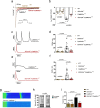Detrimental proarrhythmogenic interaction of Ca2+/calmodulin-dependent protein kinase II and NaV1.8 in heart failure
- PMID: 34782600
- PMCID: PMC8593192
- DOI: 10.1038/s41467-021-26690-1
Detrimental proarrhythmogenic interaction of Ca2+/calmodulin-dependent protein kinase II and NaV1.8 in heart failure
Abstract
An interplay between Ca2+/calmodulin-dependent protein kinase IIδc (CaMKIIδc) and late Na+ current (INaL) is known to induce arrhythmias in the failing heart. Here, we elucidate the role of the sodium channel isoform NaV1.8 for CaMKIIδc-dependent proarrhythmia. In a CRISPR-Cas9-generated human iPSC-cardiomyocyte homozygous knock-out of NaV1.8, we demonstrate that NaV1.8 contributes to INaL formation. In addition, we reveal a direct interaction between NaV1.8 and CaMKIIδc in cardiomyocytes isolated from patients with heart failure (HF). Using specific blockers of NaV1.8 and CaMKIIδc, we show that NaV1.8-driven INaL is CaMKIIδc-dependent and that NaV1.8-inhibtion reduces diastolic SR-Ca2+ leak in human failing cardiomyocytes. Moreover, increased mortality of CaMKIIδc-overexpressing HF mice is reduced when a NaV1.8 knock-out is introduced. Cellular and in vivo experiments reveal reduced ventricular arrhythmias without changes in HF progression. Our work therefore identifies a proarrhythmic CaMKIIδc downstream target which may constitute a prognostic and antiarrhythmic strategy.
© 2021. The Author(s).
Conflict of interest statement
The authors declare no competing interests.
Figures






Similar articles
-
Contribution of the neuronal sodium channel NaV1.8 to sodium- and calcium-dependent cellular proarrhythmia.J Mol Cell Cardiol. 2020 Jul;144:35-46. doi: 10.1016/j.yjmcc.2020.05.002. Epub 2020 May 11. J Mol Cell Cardiol. 2020. PMID: 32418916
-
Differential regulation of sodium channels as a novel proarrhythmic mechanism in the human failing heart.Cardiovasc Res. 2018 Nov 1;114(13):1728-1737. doi: 10.1093/cvr/cvy152. Cardiovasc Res. 2018. PMID: 29931291
-
Molecular and Functional Relevance of NaV1.8-Induced Atrial Arrhythmogenic Triggers in a Human SCN10A Knock-Out Stem Cell Model.Int J Mol Sci. 2023 Jun 15;24(12):10189. doi: 10.3390/ijms241210189. Int J Mol Sci. 2023. PMID: 37373335 Free PMC article.
-
Role of oxidants on calcium and sodium movement in healthy and diseased cardiac myocytes.Free Radic Biol Med. 2013 Oct;63:338-49. doi: 10.1016/j.freeradbiomed.2013.05.035. Epub 2013 Jun 1. Free Radic Biol Med. 2013. PMID: 23732518 Review.
-
Quantitative systems models illuminate arrhythmia mechanisms in heart failure: Role of the Na+ -Ca2+ -Ca2+ /calmodulin-dependent protein kinase II-reactive oxygen species feedback.Wiley Interdiscip Rev Syst Biol Med. 2019 Mar;11(2):e1434. doi: 10.1002/wsbm.1434. Epub 2018 Jul 17. Wiley Interdiscip Rev Syst Biol Med. 2019. PMID: 30015404 Free PMC article. Review.
Cited by
-
Characterization of novel arrhythmogenic patterns arising secondary to heterogeneous expression and activation of Nav1.8.Front Cardiovasc Med. 2025 Mar 20;12:1546803. doi: 10.3389/fcvm.2025.1546803. eCollection 2025. Front Cardiovasc Med. 2025. PMID: 40182425 Free PMC article.
-
Changes in cellular Ca2+ and Na+ regulation during the progression towards heart failure.J Physiol. 2023 Mar;601(5):905-921. doi: 10.1113/JP283082. Epub 2022 Aug 22. J Physiol. 2023. PMID: 35946572 Free PMC article.
-
Blocking NaV1.8 regulates atrial fibrillation inducibility and cardiac conduction after myocardial infarction.BMC Cardiovasc Disord. 2024 Oct 29;24(1):605. doi: 10.1186/s12872-024-04261-8. BMC Cardiovasc Disord. 2024. PMID: 39472780 Free PMC article.
-
Recent advances in CRISPR-based genome editing technology and its applications in cardiovascular research.Mil Med Res. 2023 Mar 10;10(1):12. doi: 10.1186/s40779-023-00447-x. Mil Med Res. 2023. PMID: 36895064 Free PMC article. Review.
-
CaMKII as a Therapeutic Target in Cardiovascular Disease.Annu Rev Pharmacol Toxicol. 2023 Jan 20;63:249-272. doi: 10.1146/annurev-pharmtox-051421-111814. Epub 2022 Aug 16. Annu Rev Pharmacol Toxicol. 2023. PMID: 35973713 Free PMC article. Review.
References
-
- Despa S, Islam MA, Weber CR, Pogwizd SM, Bers DM. Intracellular Na(+) concentration is elevated in heart failure but Na/K pump function is unchanged. Circulation. 2002;105:2543–2548. - PubMed
-
- Maltsev VA, et al. Novel, ultraslow inactivating sodium current in human ventricular cardiomyocytes. Circulation. 1998;98:2545–2552. - PubMed
-
- Song Y, Shryock JC, Belardinelli L. An increase of late sodium current induces delayed afterdepolarizations and sustained triggered activity in atrial myocytes. AJP Hear. Circ. Physiol. 2008;294:H2031–H2039. - PubMed
-
- Valdivia CR, et al. Increased late sodium current in myocytes from a canine heart failure model and from failing human heart. J. Mol. Cell. Cardiol. 2005;38:475–483. - PubMed
Publication types
MeSH terms
Substances
LinkOut - more resources
Full Text Sources
Medical
Molecular Biology Databases
Research Materials
Miscellaneous

